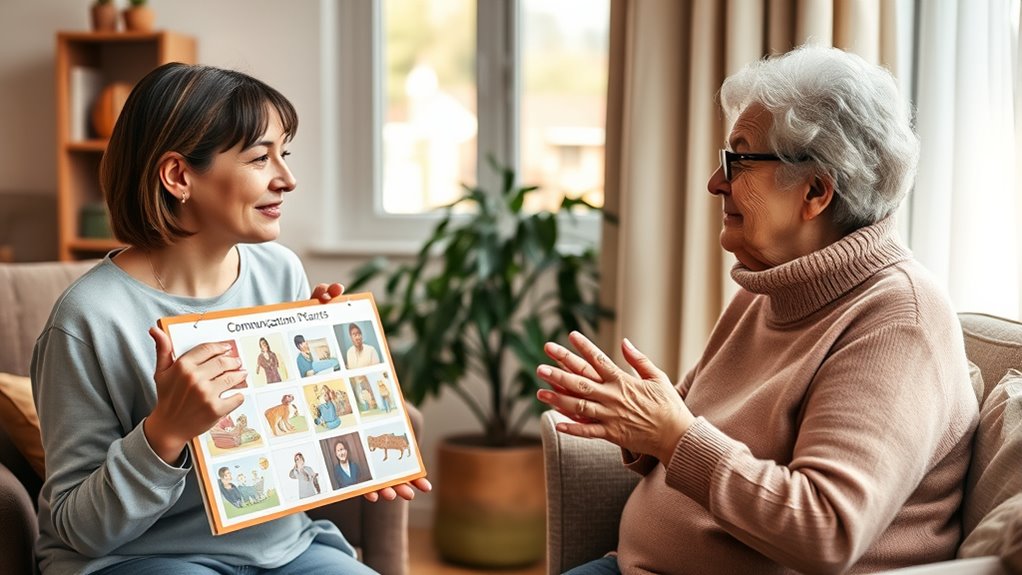To effectively communicate with your elderly loved ones, create a calm, well-lit environment free of background noise. Use simple, clear language and visual aids to support understanding. Pay close attention to their non-verbal cues and listen actively, showing empathy and patience. Respect their preferences, cultural differences, and manage hearing or vision challenges with proper devices and techniques. If you want to learn more about building trusting, meaningful conversations, keep exploring these helpful strategies.
Key Takeaways
- Use clear, simple language, speak slowly, and incorporate visual aids to enhance understanding.
- Create a calm, well-lit environment with minimal background noise to support effective communication.
- Maintain eye contact, face the person directly, and use facial expressions to reinforce messages.
- Practice active listening, observe non-verbal cues, and show empathy to build trust and connection.
- Respect personal preferences, cultural differences, and encourage the use of hearing aids and visual aids.
Creating a Comfortable Environment for Conversation

Creating a comfortable environment for conversation is essential to guarantee your elderly loved one feels at ease and engaged. Start by ensuring the room is well-lit with minimal glare to help those with visual impairments see clearly. Reduce background noise, like TVs or fans, to improve focus and hearing. Incorporating attention in practice by minimizing distractions can significantly boost the quality of your interactions. Arrange seating at eye level, facing each other directly, to facilitate face-to-face communication and make it easier to read lips and pick up on non-verbal cues. Maintaining a calm atmosphere during less busy times minimizes distractions and fatigue. Using familiar surroundings that evoke feelings of safety and relaxation can significantly enhance the comfort level during conversations. A comfortable setting with a quiet, calm ambiance helps your loved one feel more comfortable, making conversations more meaningful and effective. Additionally, checking store hours in advance can help plan visits during quieter times when your loved one may feel more relaxed. Being aware of elderly needs and medical conditions ensures you tailor your environment to better support their communication preferences and challenges.
Using Clear and Simple Language

To make certain your elderly loved ones understand you clearly, it’s important to use simple, straightforward language. Speak in clear language and avoid medical jargon or complex words. Use short sentences and slow speech, ensuring your volume is gentle but audible. Incorporate visual aids like pictures and charts to help clarify information and support memory. Writing down key instructions in simple words and providing printed materials can reinforce your message. Regularly confirm understanding by asking your loved one to paraphrase or explain what you said. When talking, keep it face-to-face and use short questions to engage them. Developing your Cognitive CQ can help you better understand your loved one’s cultural background and communication preferences, making your conversations more effective. Recognizing angel numbers related to love and relationships can also help you better interpret your loved one’s feelings and needs, enriching your communication. Additionally, being aware of modern sneaker trends like Nike Tech can help you connect over shared interests, fostering more meaningful conversations. Incorporating effective communication strategies such as active listening and patience can further enhance your understanding and strengthen your relationship. Being mindful of toilet maintenance habits and the importance of clear instructions can also improve daily interactions and reduce misunderstandings.
Employing Active Listening and Observing Non-Verbal Cues

Since words don’t always tell the full story, actively listening and observing non-verbal cues are essential when communicating with elderly loved ones. Engage in active listening by giving your full attention, maintaining eye contact, and nodding to show understanding. Watch for non-verbal cues like facial expressions, body language, and gestures that reveal unspoken feelings or confusion. Pay attention to tone of voice, pauses, and sighs, which can signal emotional cues or underlying concerns. Observing these cues helps you better understand their true message. Recognizing subtle signals like restlessness or withdrawal allows you to adjust your approach, fostering more meaningful and supportive communication with your elderly loved ones. Incorporating tools like portable camping gear can also help create a comfortable environment that encourages open dialogue. Being aware of privacy considerations ensures that your interactions respect their dignity and comfort. Additionally, understanding the importance of color accuracy in visual perception can help you interpret their reactions more accurately, especially if they have visual impairments or sensitivities. Furthermore, staying updated on common health issues such as senior texting humor can facilitate more engaging conversations and build trust. Being mindful of data privacy concerns can also help protect their personal information during digital communication.
Respecting Personal Preferences and Cultural Differences

Building on the importance of observing non-verbal cues, showing respect for your elderly loved ones involves honoring their personal preferences and cultural backgrounds. Respect starts with asking how they prefer to be addressed—by first name, nickname, or title—affirming their dignity. Recognize and adapt to cultural differences in social customs, eye contact, and gestures to foster respectful interactions. Use open-ended questions to learn about their beliefs, values, and communication styles, avoiding assumptions. Tailor your approach by considering their language preferences and social norms. Remember, demonstrating respect involves active listening, observing non-verbal cues, and integrating their cultural and personal preferences into your conversations. Incorporating cultural sensitivities and diverse designs into your communication approach can further enhance mutual understanding. Being aware of water-related customs or traditions can also help you connect more deeply with their background. Additionally, understanding cybersecurity awareness can help you safeguard their personal information when communicating digitally. This creates a trusting environment that honors their individuality and promotes meaningful connection.
Managing Hearing and Vision Challenges Effectively

To help your elderly loved ones communicate better, speak clearly and slowly while facing them to support hearing and lip-reading. Use visual aids like large-print materials and make sure good lighting to improve their visual understanding. Minimize background noise and encourage the use of glasses to make conversations more effective. Additionally, incorporating assistive devices such as hearing aids or magnifiers can significantly enhance their ability to comprehend and engage in conversations. Ensuring the halal status of foods they consume, including familiar snacks and beverages, can also contribute to their overall well-being and peace of mind. Maintaining the functionality of equipment, including cleaning and inspecting for issues, can prevent communication breakdowns during projects. Moreover, understanding how Natural Language Processing (NLP) enhances communication tools can help you select the most effective technology for your loved ones.
Enhancing Hearing Clarity
When communicating with elderly loved ones who experience hearing and vision challenges, you can considerably improve understanding by speaking clearly, slowly, and in a steady voice. This enhances auditory clarity and makes it easier for them to process what you say.
To optimize communication, consider these tips:
- Encourage the use of hearing aids, ensuring they fit well and work properly.
- Speak in a moderate volume, avoiding shouting or whispering.
- Minimize background noise, such as TV or radio, to reduce distractions.
- Use facial expressions, eye contact, and visual cues like notes or pictures to reinforce your message.
- Be mindful of sound amplification and ensure the environment supports clear hearing, such as reducing echo or background noise.
These strategies help overcome age-related hearing loss, making conversations more effective and meaningful.
Improving Visual Accessibility
Ensuring good visual accessibility is essential for effective communication with elderly loved ones who face hearing and vision challenges. Adequate lighting reduces glare and shadows, making it easier for them to see clearly.
Encourage the use of their prescribed glasses, and check they wear them correctly during conversations. Use large-print materials with high contrast and minimal glare to improve readability for those with visual impairments.
Incorporate visual aids like charts, pictures, and models to support understanding and compensate for visual challenges.
Minimize background noise and visual distractions to help your loved ones focus and process information more easily.
Building Trust Through Empathy and Respect

Building trust with your elderly loved ones starts with showing genuine empathy and respect. You can foster this by maintaining eye contact, sitting face-to-face, and offering gentle touches to create a sense of connection and reassurance.
Building trust begins with genuine empathy, respect, eye contact, and gentle touches to foster connection and reassurance.
Practice active listening—nodding, paraphrasing, and giving your full attention—to validate their feelings and deepen understanding.
Respect their preferences for names, communication styles, and cultural norms to affirm their dignity and autonomy.
Use empathetic language and acknowledge their emotions, making them feel supported and understood.
Remember, patience, kindness, and nonverbal communication help build an emotional connection and trust.
Key points to focus on:
- Engage in active listening
- Respect individual preferences
- Use empathetic language
- Practice patience and kindness
Frequently Asked Questions
What Is the Best Method to Interacting With Elderly Patients?
When interacting with elderly loved ones, you want to build trust first. Greet them warmly, make eye contact, and offer gentle touches if appropriate.
Use simple language, speak slowly, and focus on one topic at a time.
Confirm understanding with teach-back methods.
Minimize distractions, give extra time, and use visual aids or written summaries.
These strategies help guarantee clear, respectful, and effective communication.
Which of These Is a Helpful Technique When Communicating With an Elderly Patient?
Imagine your words are gentle waves reaching a distant shore—that’s how clear and slow your speech should be.
When communicating with an elderly loved one, speak slowly, clearly, and loudly enough without shouting.
Use simple words, focus on one idea at a time, and check for understanding.
Visual aids and encouraging questions act like guiding lights, helping them navigate your message easily and confidently.
What Are 6 Communication Techniques You Should Use When Communicating With a Person With Dementia?
When communicating with a person with dementia, you should use six key techniques. Speak slowly, clearly, and calmly, making eye contact to show you’re listening.
Use simple language and short sentences to reduce confusion.
Incorporate visual aids or gestures to support understanding.
Be patient and give them extra time to respond, offering gentle prompts if needed.
Maintain a reassuring tone and stay at their eye level to foster connection.
Which Is an Example of Good Communication Techniques When Communicating With an Elderly Patient?
Thinking about good communication techniques is like tuning a delicate instrument—you want harmony. You speak slowly and clearly, ensuring your loved one understands.
Maintain eye contact, sit face-to-face to build trust, and use simple words instead of medical jargon.
Confirm comprehension with teach-back methods and incorporate visual aids when needed.
These actions together create a supportive environment, making your loved one feel respected, understood, and cared for every step of the way.
Conclusion
By nurturing patience and understanding, you create a bridge of trust that spans any gap. Think of your conversations as gentle streams flowing steadily, guiding your loved ones with kindness and clarity. When you listen actively and respect their world, you’re planting seeds of connection that blossom into deeper bonds. With every compassionate word, you paint a picture of love and respect—transforming everyday chats into beautiful, enduring tapestries of shared understanding.








